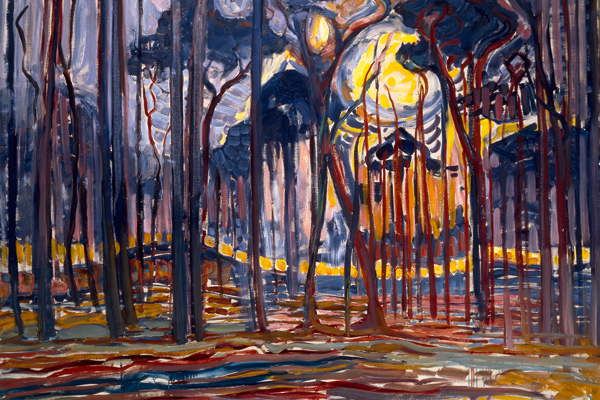Van Gogh to Kandinsky presents a rare and exciting opportunity to see some 60 paintings as examples of landscape symbolism from major international institutions and private collections. The exhibition extends beyond the usual north European definitions of this subject, with the coupling of the emotionally charged graphic-colourist van Gogh with the increasingly reductive and programmatic application of colour-to-form associated with late Kandinsky. It challenges, therefore, conventional categorisations of modern European art. Who would think, moreover, that Lord Leighton, Hammershøi, Monet and Mondrian could share a common thesis, let alone inhabit the same gallery rooms?
In lesser hands, such an ambitious project could have descended into chaos and visual incoherence. However, the exhibition is displayed in several categories — Arcadia, Moods of Nature, Dreams and Vision, Silent Cities, Rhythms of Nature, and Towards Abstraction— that serve as a good introduction to what is both a vast and complex subject. The catalogue makes clear that landscape symbolism was not a defined movement, but more a response to dramatically changing events in Europe, Russia and North America. These changes encompassed scientific thought, discoveries and inventions; Christian and spiritual thought (notably theosophy and its interest in the symbolism of colour); the exploration of the world and the human mind; and a yearning for individual expression, sometimes predicated on national identity.
In this exhibition we can find common visual threads: brilliant sunshine (Hodler, Albert Trachsel and Jens Ferdinand Willumsen); glorious sunsets (early Mondrian); brooding and ethereal city nightscapes (Fernand Khnopff, Henri Le Sidaner and Whistler); the spectacular (G.F. Watts and Léon Bakst) or phantasmagoric (for example, ‘The Horses of Neptune’, a large-scale painting by Walter Crane); the dreamlike (Eugène Carrière and Harald Sohlberg), the ‘sense of mystery’ (Odilon Redon) and the spiritual (Gauguin). The exhibition suggests that the legacy of such depth of experimentation was non-representational art and the beginnings of Modernism (hence the 1910 cut-off date), manifested in paintings by Kandinsky and Mondrian, as well as the symphonic ones by the Czech artist Kupka and the little-known Lithuanian composer and painter Ciurlionis.
The origins of symbolism can be traced back to art as an expression of individual experiences, associated with 19th-century northern Romanticism and British painters such as Constable, with his concern for ‘sentiment’ and ‘feeling’. For these artists, an individual’s sensory experiences were interpreted as valued sources of knowledge and inspiration, providing the key to the break with purely representational art. The elegantly written accompanying catalogue provides a wealth of information.
In Van Gogh to Kandinsky, Edvard Munch is represented by two stunning snowscapes, in which the narrative content and the human figure are absent. But both aspects can be explored in an exhibition devoted to his prints, which are on loan from the Gundersen Collection in Norway. On display are 60 prints (black and white, and colour lithographs, woodcuts, drypoints and etchings) in various states of completion, including some rare examples, such as ‘Two Women on the Shore’, ‘The Sick Child’ and self-portraits. Landscape symbolism features in the various versions of ‘Towards the Forest’, 1897, which are also good examples of Munch’s innovative printmaking techniques.
The exhibition’s concluding section explains how Munch was invited by the Scottish Society of Artists to give a solo show in 1931. This inspired artists such as William MacTaggart, but also the wrath of one letter writer who objected to Munch’s ‘extraordinary divergence from the simple art of nature’. Scotland has come a long way since then…






Comments